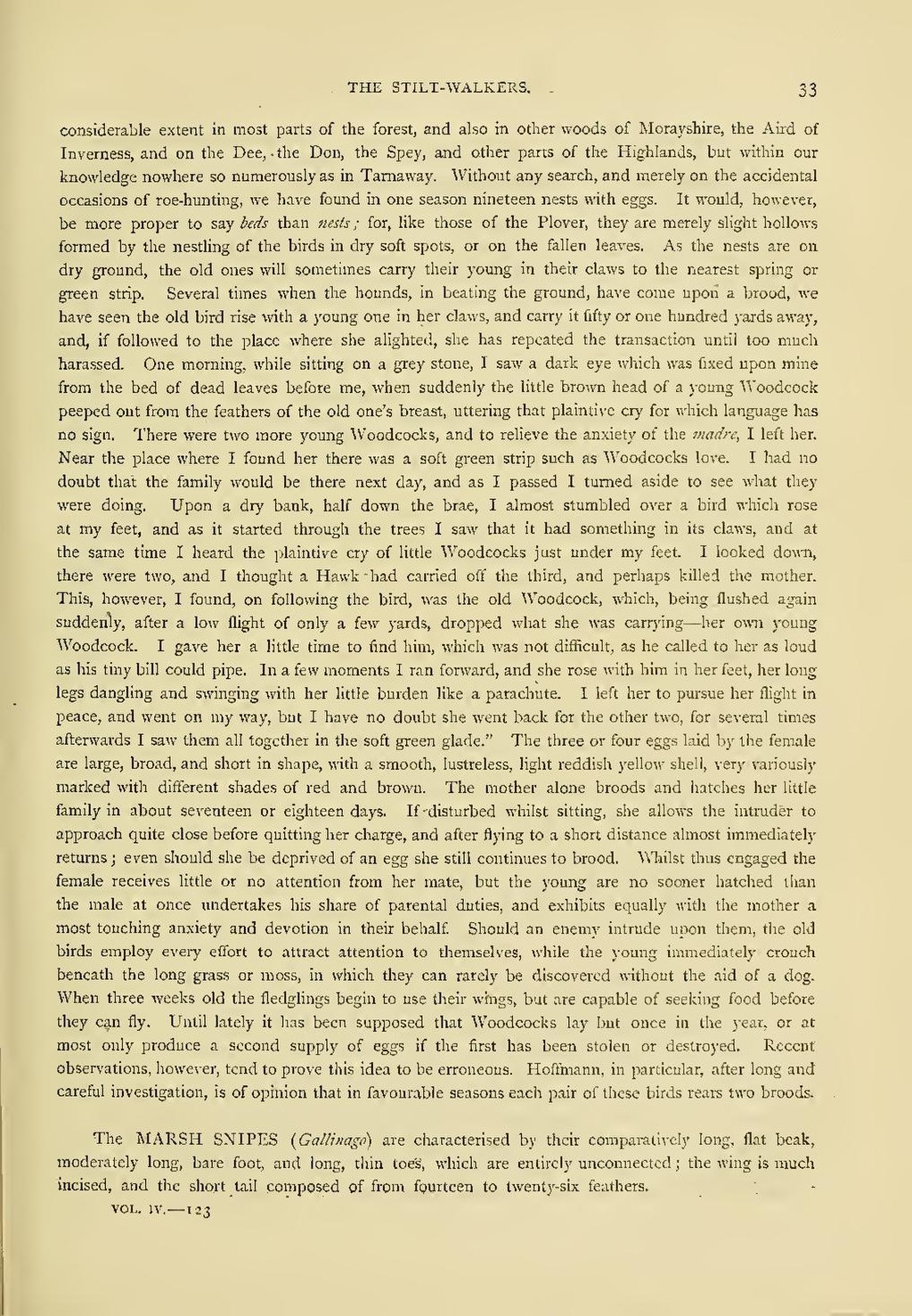considerable extent in most parts of the forest, and also in other woods of Morayshire, the Aird of Inverness, and on the Dee, the Don, the Spey, and other parts of the Highlands, but within our knowledge nowhere so numerously as in Tarnaway. Without any search, and merely on the accidental occasions of roe-hunting, we have found in one season nineteen nests with eggs. It would, however, be more proper to say beds than nests; for, like those of the Plover, they are merely slight hollows formed by the nestling of the birds in dry soft spots, or on the fallen leaves. As the nests are on dry ground, the old ones will sometimes carry their young in their claws to the nearest spring or green strip. Several times when the hounds, in beating the ground, have come upon a brood, we have seen the old bird rise with a young one in her claws, and carry it fifty or one hundred yards away, and, if followed to the place where she alighted, she has repeated the transaction until too much harassed. One morning, while sitting on a grey stone, I saw a dark eye which was fixed upon mine from the bed of dead leaves before me, when suddenly the little brown head of a young Woodcock peeped out from the feathers of the old one's breast, uttering that plaintive cry for which language has no sign. There were two more young Woodcocks, and to relieve the anxiety of the madre, I left her. Near the place where I found her there was a soft green strip such as Woodcocks love. I had no doubt that the family would be there next day, and as I passed I turned aside to see what they were doing. Upon a dry bank, half down the brae, I almost stumbled over a bird which rose at my feet, and as it started through the trees I saw that it had something in its claws, and at the same time I heard the plaintive cry of little Woodcocks just under my feet. I looked down, there were two, and I thought a Hawk had carried off the third, and perhaps killed the mother. This, however, I found, on following the bird, was the old Woodcock, which, being flushed again suddenly, after a low flight of only a few yards, dropped what she was carrying—her own young Woodcock. I gave her a little time to find him, which was not difficult, as he called to her as loud as his tiny bill could pipe. In a few moments I ran forward, and she rose with him in her feet, her long legs dangling and swinging with her little burden like a parachute. I left her to pursue her flight in peace, and went on my way, but I have no doubt she went back for the other two, for several times afterwards I saw them all together in the soft green glade." The three or four eggs laid by the female are large, broad, and short in shape, with a smooth, lustreless, light reddish yellow shell, very variously marked with different shades of red and brown. The mother alone broods and hatches her little family in about seventeen or eighteen days. If disturbed whilst sitting, she allows the intruder to approach quite close before quitting her charge, and after flying to a short distance almost immediately returns; even should she be deprived of an egg she still continues to brood. Whilst thus engaged the female receives little or no attention from her mate, but the young are no sooner hatched than the male at once undertakes his share of parental duties, and exhibits equally with the mother a most touching anxiety and devotion in their behalf. Should an enemy intrude upon them, the old birds employ every effort to attract attention to themselves, while the young immediately crouch beneath the long grass or moss, in which they can rarely be discovered without the aid of a dog. When three weeks old the fledglings begin to use their wings, but are capable of seeking food before they can fly. Until lately it has been supposed that Woodcocks lay but once in the year, or at most only produce a second supply of eggs if the first has been stolen or destroyed. Recent observations, however, tend to prove this idea to be erroneous. Hoffmann, in particular, after long and careful investigation, is of opinion that in favourable seasons each pair of these birds rears two broods.
The MARSH SNIPES (Gallinago) are characterised by their comparatively long, flat beak, moderately long, bare foot, and long, thin toes, which are entirely unconnected; the wing is much incised, and the short tail composed of from fourteen to twenty-six feathers.
